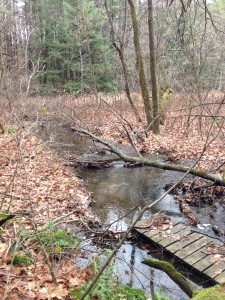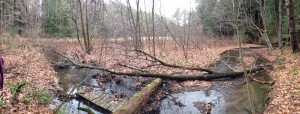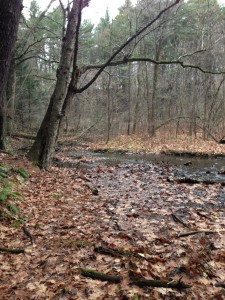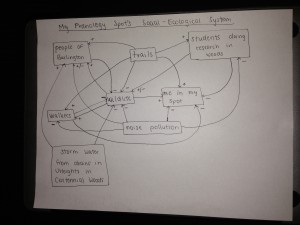Monthly Archives: December 2015
Bibliography
All photographs were taken by me, Ben Langton, on the date that I say they were taken in my posts.
Photos Taken on December 4, 2015
Evidence of Land-Use History
Before Centennial Woods was deemed a natural area, human beings used the landscape for other purposes. I did some first-hand exploration to see what I could find out about the land-use history in my specific spot. My spot is located on the banks of Centennial Brook. There is evidence of erosion on the shoreline, which leads me to believe that this place would have been prime land for farming. The nutrients from the river would likely have flooded onto the land occasionally, enriching the soil to grow crops well. There are also a lack of very old trees in my spot, which is another clue for farming. I am also led to believe that there was an apple or crabapple farm or grove nearby at one time because on the walk to my spot, I noticed some crabapple trees, which would be very out of place in an undisturbed forest.
Social-Ecological System of My Spot
Social-Ecological System Explained
I made “wildlife” the focal component of my social-ecological system. This is because Centennial Woods is wildlife. The woods are composed of trees, soils, birds, mammals, and water to make up a natural, largely-undeveloped portion of the city of Burlington, Vermont. Since my phenology spot is located inside of Centennial Woods, and I mentioned that Centennial Woods is wildlife, it makes sense for the most involved aspect of the system to be centralized. The other components of my social-ecological system include the people of Burlington, trails, students conducting research in the woods, walkers, myself in my spot, anthropogenic noise pollution, and storm water from drains in University Heights in Centennial Brook. For each of these, I will explain why there is an arrow pointing from one component to another and why the arrow has either a positive or negative connotation to it.
People of Burlington
- negative arrow toward wildlife because Burlington is an urban area whose infrastructure infringes upon the area’s natural areas
Students Doing Research In Woods
- postive and negative arrow going to wildlife because they often step off the path and likely trample vegetation, yet the work they do is often for the benefit of the wildlife in Centennial Woods
- negative arrow toward me in my spot because sometimes when I visit my phenology spot, students are conducting research in the same place or close by which disrupts me physically if I have to move and it makes it tougher to listen for birds
Trails
- positive arrow for people of Burlington, walkers, students doing research, and myself because they provide access to the woods
- negative arrow toward wildlife because the paths fragment the forest habitat and compact the soils
Walkers
- negative arrow toward wildlife because they can be disruptive through talking and may stray off the trail or pollute
- negative arrow toward me because they disrupt wildlife, which is what I am trying to observe
Wildlife
- positive arrow to the people of Burlington for the ecosystem services the natural area provides to the city
- positive arrow to walkers because often times, people walk in the woods in hopes of finding animals and to be surrounded by trees
- positive arrow to me in my spot because wildlife is what gives me material to use in my phenology blog
Noise Pollution
- negative effect on wildlife because the noise drowns out bird calls and the unnatural sounds may stress out some of the animals
- negative arrows to walkers, me in my spot, and students doing research because the noise overpowers the natural sounds of the woods
- positive and negative arrows for the people of Burlington because they benefit from the airplanes, yet also have to deal with the loud noises
Storm Water Draining into Centennial Brook
- negative effect on wildlife because the water probably contains contaminants from vehicles and students who pollute the water that goes into the storm drains
- positive arrow to people of Burlington because the drains are a way of preventing flooding




